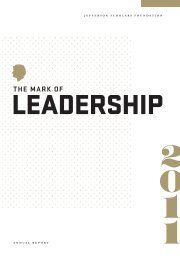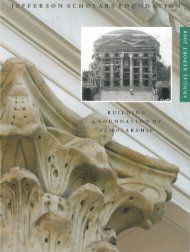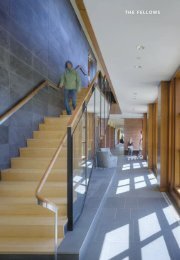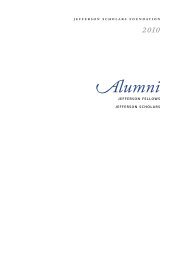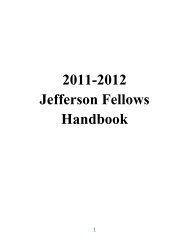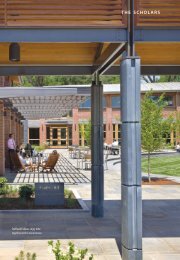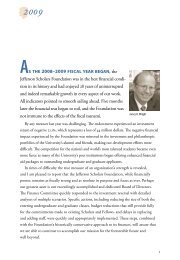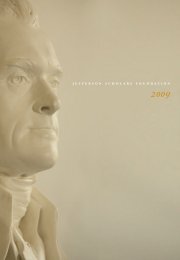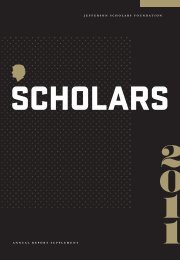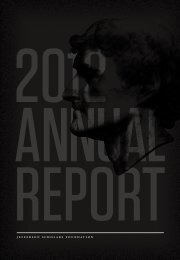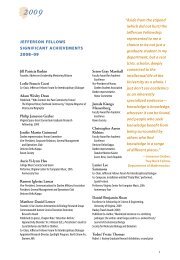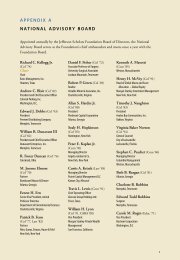2010 - Jefferson Scholars Foundation
2010 - Jefferson Scholars Foundation
2010 - Jefferson Scholars Foundation
You also want an ePaper? Increase the reach of your titles
YUMPU automatically turns print PDFs into web optimized ePapers that Google loves.
the fellows<br />
Jameson Graber, the Trey Beck Fellow (Mathematics), discusses control theory in acoustic systems.<br />
tion. In privileging this interstitial<br />
discourse — the language of<br />
cultural abjection — Loy adopts<br />
both the formal and ideological<br />
underpinnings of Fountain’s<br />
relationship to excreta in order<br />
to create a new model for poetic<br />
productivity and the figure of<br />
the enduring artist.<br />
p. jameson<br />
graber<br />
mathematical Analysis<br />
of Structural Acoustic<br />
Systems<br />
The purpose of this talk is to<br />
explain how mathematics can<br />
contribute to the study of a<br />
real-world engineering problem,<br />
namely that of stabilizing an<br />
acoustic chamber (e.g., airplane<br />
fuselage). I will begin by explaining<br />
the physical scenario — an<br />
acoustic chamber with “noise”<br />
affecting acoustic pressure —<br />
which engineers wish to control<br />
(i.e., protect system from damage<br />
or other unwanted effects<br />
of noise). The core of my presentation<br />
is to explain how the<br />
particular area of mathematics<br />
called control theory is used to<br />
analyze this system. I will summarize<br />
the basic philosophy of<br />
control theory in a three-step<br />
process: modeling the physical<br />
phenomena using a system of<br />
partial differential equations,<br />
studying the properties of the<br />
new mathematical problem, and,<br />
finally, altering the model in<br />
order to obtain desired behavior<br />
(e.g., to obtain or enhance stability).<br />
Having explained the basic<br />
philosophy of control theory, I<br />
will show how we apply it in<br />
the case of structural acoustic<br />
systems. I will present the differential<br />
equations model that I<br />
am studying, explain what properties<br />
of the model need to be<br />
demonstrated mathematically,<br />
and then describe the control<br />
methods hoped for in this model.<br />
Finally, I will give a qualitative<br />
(non-technical) description of<br />
the mathematical techniques I<br />
use to contribute to our understanding<br />
of structural acoustic<br />
systems.<br />
jenifer m.<br />
guimond<br />
“greening”<br />
Operations<br />
Strategy: A<br />
Life Cycle<br />
Approach<br />
In today’s business<br />
environment,<br />
“green” initiatives<br />
are beginning to<br />
permeate operations<br />
strategy<br />
across industries.<br />
Companies<br />
that have embraced<br />
a life<br />
cycle approach to<br />
operations are recognizing<br />
that economic success<br />
is reliant on more than just<br />
traditional profitability and<br />
that a firm’s stakeholder base<br />
consists of more than shareholders.<br />
Employees, communities,<br />
and the environment represent<br />
additional stakeholders that<br />
contribute to long-term sustainable<br />
firm success. A life cycle<br />
approach to operations allows<br />
an organization to evaluate<br />
the benefits, risks, and costs of<br />
a product or technology from<br />
inception to end of life use, and<br />
ultimately to the reuse of product<br />
components. It ensures that<br />
businesses are thinking about<br />
operations in the larger context<br />
of long-term sustainability. In<br />
addition, life cycle–based operations<br />
and sustainable business<br />
practices can lead to process<br />
improvement, product innovation,<br />
and increased profitability.<br />
In evaluating the value added by<br />
green operations and strategic<br />
sustainability initiatives, the life<br />
cycle view can offer a method of<br />
understanding how cost tradeoffs<br />
interact with one another<br />
11



